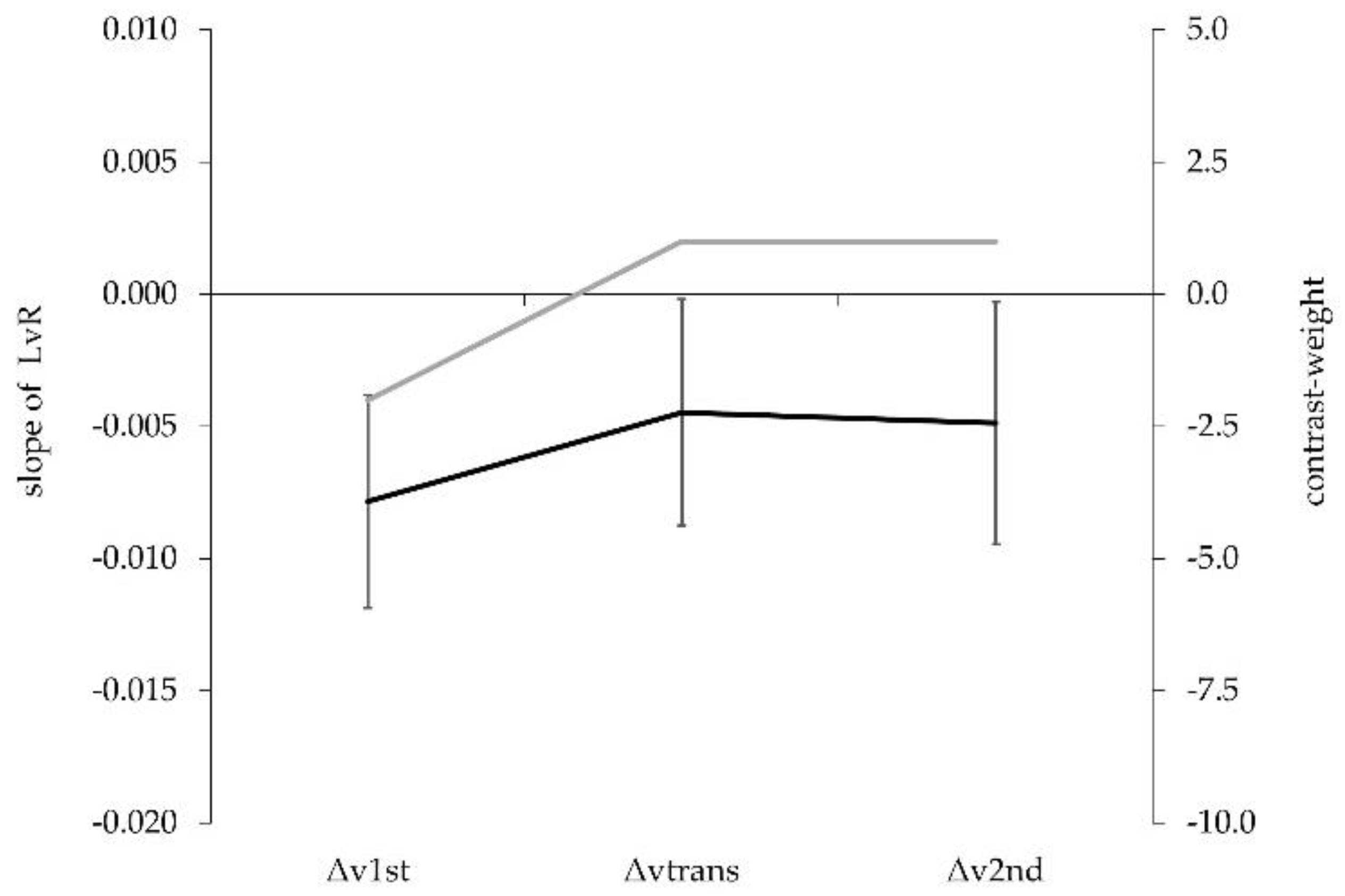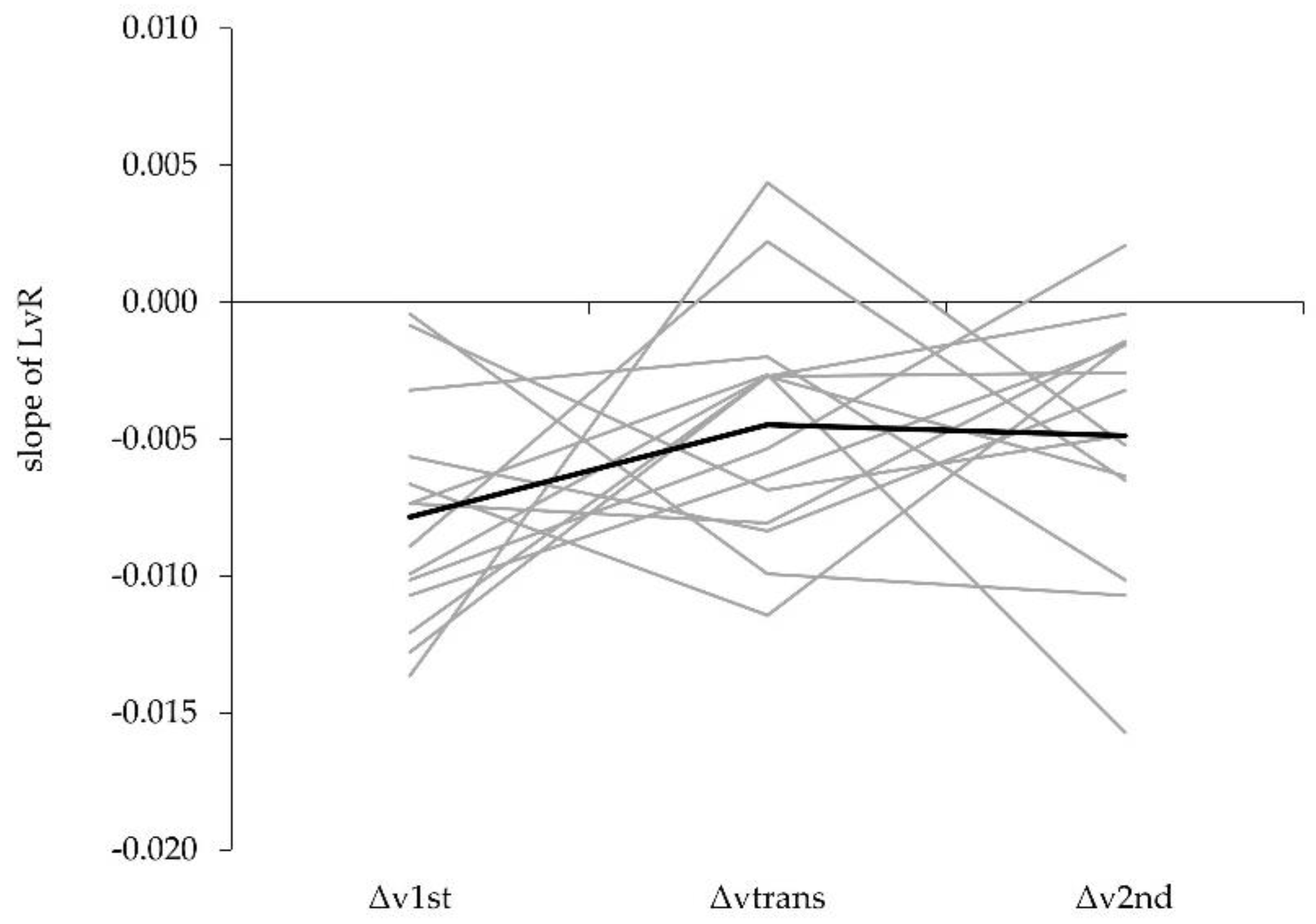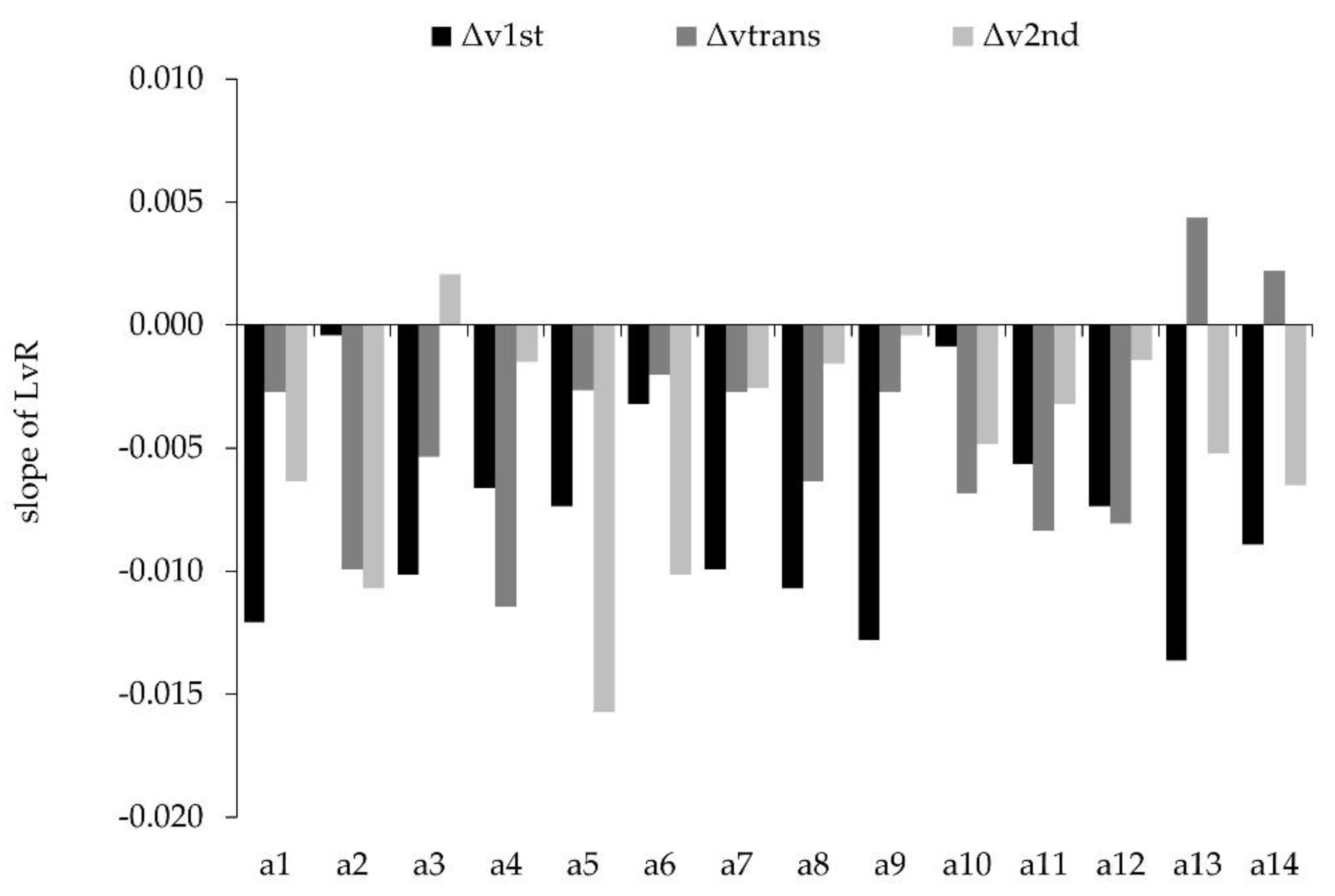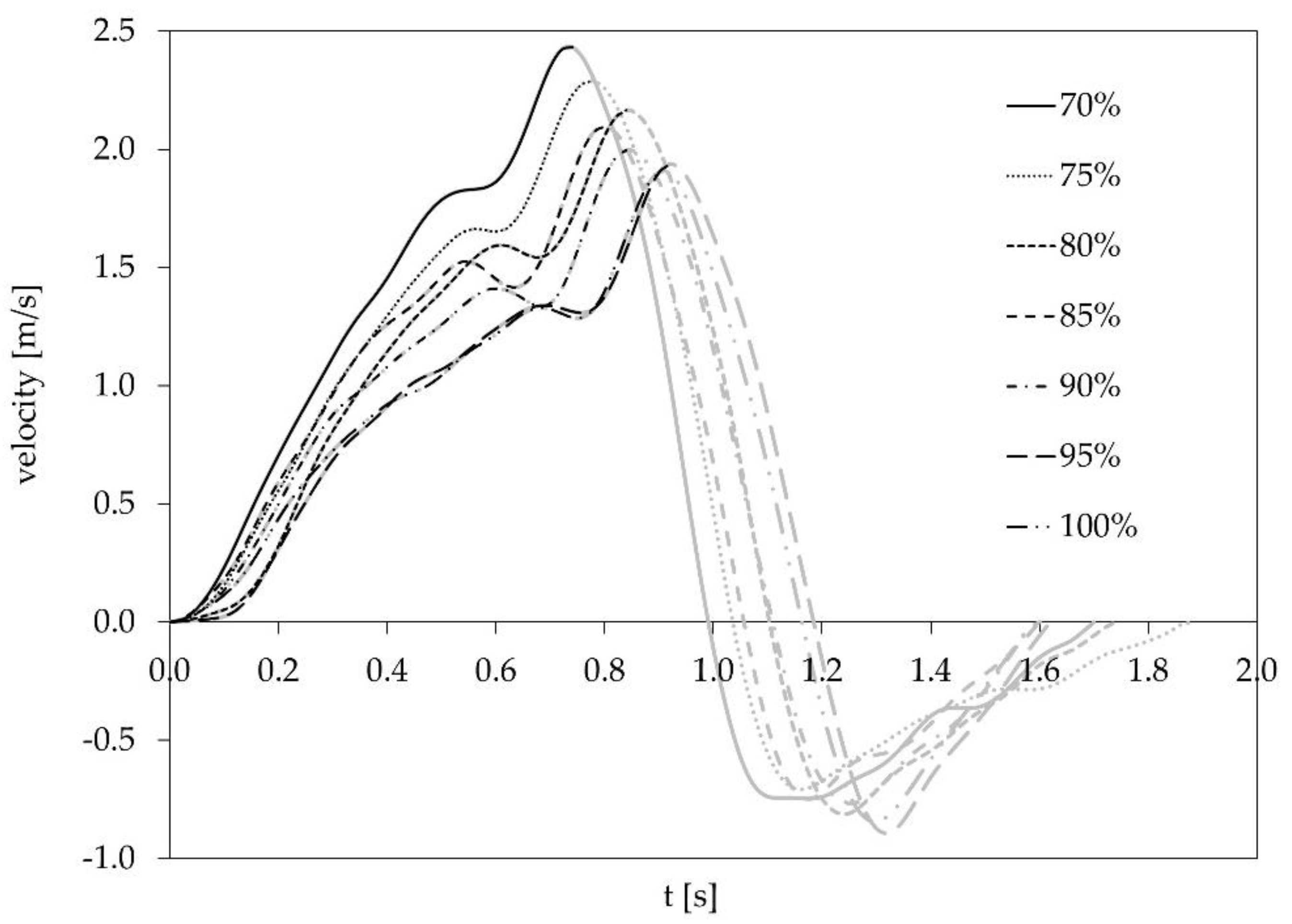Effects of the Barbell Load on the Acceleration Phase during the Snatch in Elite Olympic Weightlifting
Abstract
:1. Introduction
2. Materials and Methods
2.1. Participations
2.2. Source of Data
2.3. Characterization of the Acceleration Phase
2.4. Barbell Kinematics
2.5. Statistical Analyses
3. Results
4. Discussion
5. Conclusions
Author Contributions
Funding
Acknowledgments
Conflicts of Interest
References
- Böttcher, J.; Deutscher, E. Biomechanische Ergebnisse zur Bewegungstechnik im Gewichtheben (Reißen). Leistungssport 1999, 29, 55–62. [Google Scholar]
- Gourgoulis, V.; Aggelousis, N.; Mavromatis, G.; Garas, A. Three-dimensional kinematic analysis of the snatch of elite Greek weightlifters. J. Sports Sci. 2000, 18, 643–652. [Google Scholar] [CrossRef] [PubMed]
- Häkkinen, K.; Kauhanen, H.; Komi, P.V. Biomechanical changes in the olympic weightlifting technique of the snatch and clean & jerk from submaximal to maximal loads. Scand. J. Sports Sci. 1984, 6, 57–66. [Google Scholar]
- Garhammer, J. Biomechanical profiles of Olympic weightlifters. Int. J. Sport Biomech. 1985, 1, 122–130. [Google Scholar] [CrossRef] [Green Version]
- Sandau, I.; Lippmann, J.; Seidel, I. Snatch technique of male international weightlifters: A long-term analysis. EWF Sci. Mag. 2016, 2, 6–15. [Google Scholar]
- Campos, J.; Poletaev, P.; Cuesta, A.; Pablos, C.; Carratalá, V. Kinematical analysis of the snatch in elite male junior weightlifters of different weight categories. J. Strength Cond. Res. 2006, 20, 843–850. [Google Scholar] [CrossRef]
- Isaka, T.; Okada, J.; Funato, K. Kinematic analysis of the barbell during the snatch movement in elite Asian weightlifters. J. Appl. Biomech. 1996, 12, 508–516. [Google Scholar] [CrossRef]
- Chiu, H.-T.; Wang, C.-H.; Cheng, K.B. The three-dimensional kinematics of a barbell during the snatch of Taiwanese weightlifters. J. Strength Cond. Res. 2010, 24, 1520–1526. [Google Scholar] [CrossRef]
- Bartonietz, K.E. Biomechanics of the snatch: Toward a higher training efficiency. Strength Cond. 1996, 18, 24–31. [Google Scholar] [CrossRef]
- Kipp, K.; Harris, C. Patterns of barbell acceleration during the snatch in weightlifting competition. J. Sports Sci. 2014, 33, 1467–1471. [Google Scholar] [CrossRef]
- Conceicao, F.; Fernandes, J.; Lewis, M.; Gonzalez-Badillo, J.J.; Jimenez-Reyes, P. Movement velocity as a measure of exercise intensity in three lower limb exercises. J. Sports Sci. 2016, 34, 1099–1106. [Google Scholar] [CrossRef] [PubMed] [Green Version]
- Ruf, L.; Chery, C.; Taylor, K.L. Validity and reliability of the load-velocity relationship to predict the one-repetition maximum in deadlift. J. Strength Cond. Res. 2018, 32, 681–689. [Google Scholar] [CrossRef] [PubMed]
- Stone, M.H.; Pierce, K.; Sands, W.A.; Stone, M.E. Weightlifting: Program design. Strength Cond. J. 2006, 28, 10–17. [Google Scholar] [CrossRef]
- Stone, M.H.; Pierce, K.C.; Sands, W.A.; Stone, M.E. Weightlifting: A brief overview. Strength Cond. J. 2006, 28, 50–66. [Google Scholar] [CrossRef]
- Suchomel, T.J.; Comfort, P.; Stone, M.H. Weightlifting pulling derivatives: Rationale for implementation and application. Sports Med. 2015, 45, 823–839. [Google Scholar] [CrossRef]
- Garhammer, J.; Takano, B. Training for weightlifting. In Strength and Power in Sport; Komi, P.V., Ed.; Blackwell Science: Oxford, UK, 2003; pp. 502–515. [Google Scholar] [CrossRef]
- Suchomel, T.J.; Comfort, P.; Lake, J. Enhancing the force velocity profile of athletes using weightlifting derivatives. Strength Cond. J. 2017, 39, 10–20. [Google Scholar] [CrossRef]
- Pistilli, E.E.; Kaminsky, D.E.; Totten, L.M.; Miller, D.R. Incorporatining one week of planned overreaching into the training program of weightlifters. Strength Cond. J. 2008, 30, 39–44. [Google Scholar] [CrossRef] [Green Version]
- Baumann, W.; Gross, V.; Quade, K.; Galbierz, P.; Schwirtz, A. The snatch technique of world class weightlifters at the 1985 world championships. Int. J. Sport Biomech. 1988, 4, 68–89. [Google Scholar] [CrossRef]
- Hadi, G.; Akkuş, H.; Harbili, E. Three-dimensional kinematic analysis of the snatch technique for lifting different barbell weights. J. Strength Cond. Res. 2012, 26, 1568–1576. [Google Scholar] [CrossRef]
- Ho, K.W.; Williams, M.D.; Wilson, C.J.; Meehan, D.L. Using three-dimensional kinematics to identify feedback for the snatch: A case study. J. Strength Cond. Res. 2011, 25, 2773–2780. [Google Scholar] [CrossRef]
- Medvedjev, A.; Frolov, V.; Lukashev, A.; Krasov, E. A comparative analysis of the clean and clean pulls technique with various weights. Sov. Sports Rev. 1983, 1, 17–19. [Google Scholar]
- Frolov, V.; Efimov, N.; Vanagas, M. Training weights for snatch pulls. Sov. Sports Rev. 1983, 3, 58–61. [Google Scholar]
- Gourgoulis, V.; Aggeloussis, N.; Antoniou, P.; Christoforidis, C.; Mavromatis, G.; Garas, A. Comparative 3-dimensional kinematic analysis of the snatch technique in elite male and female greek weightlifters. J. Strength Cond. Res. 2002, 16, 359–366. [Google Scholar]
- Sandau, I.; Jentsch, H.; Bunk, M. Realanalyzer HD—A real-time barbell tracking software for weightlifting. EWF Sci. Mag. 2019, 5, 14–23. [Google Scholar]
- Enoka, R.M. The pull in olympic weightlifting. Med. Sci. Sports 1979, 11, 131–137. [Google Scholar] [PubMed]
- Takano, B. Coaching optimal technique in the snatch and clean and jerk—Part I. Nat. Strength Cond. J. 1993, 15, 33–39. [Google Scholar] [CrossRef]
- Knudson, D.V.; Morrison, C.S. Qualitative Analysis of Human Movement; Human Kinetics: Champaign, IL, USA, 1997. [Google Scholar]
- OpenCV. Template Matching. Available online: https://docs.opencv.org/3.4/de/da9/tutorial_template_matching.html (accessed on 10 April 2020).
- Sandau, I.; Lippmann, J.; Jentsch, H.; Seidel, I. Reliabilität des Realanalyzer, ein 2-D-Messsystems zur Echtzeiterfassung der Hantelbewegung im Gewichtheben. In Proceedings of the “NeuroMotion” Aufmerksamkeit, Automatisierung, Adaptation, Münster, Germany, 21–23 March 2012; p. 126. [Google Scholar]
- Rosenthal, R.; Rosenow, R.L. Contrast Analysis: Focused Comparisons in the Analysis of Variance; Cambridge University Press: Cambridge, UK, 1985. [Google Scholar]
- Furr, R.M. A contrast analysis approach to change. Educ. Res. Eval. 2008, 14, 335–362. [Google Scholar] [CrossRef]
- R Core Team. R: A Language and Environment for Statistical Computing; R Foundation for Statistical Computing: Vienna, Austria, 2019. [Google Scholar]
- Cohen, J. Statistical Power Analysis for the Behavioral Sciences, 2nd ed.; Erlbaum: Hillsdale, MI, USA, 1988. [Google Scholar]
- Kraemer, W.J. Exercise prescription in weight training: A needs analysis. Nat. Strength Cond. J. 1983, 5, 64–65. [Google Scholar] [CrossRef]
- Morin, J.B.; Samozino, P. Interpreting power-force-velocity profiles for individualized and specific training. Int. J. Sports Physiol. Perform. 2016, 11, 267–272. [Google Scholar] [CrossRef]
- Marques, M.C.; Marinho, D.A.; van den Tillaar, R. A load-velocity relationship for men and women in overhead throwing performance. J. Sports Sci. Med. 2010, 9, 524–526. [Google Scholar]
- Cormie, P.; McCaulley, G.O.; McBride, J.M. Power versus strength-power jump squat training: Influence on the load-power relationship. Med. Sci. Sports Exerc. 2007, 39, 996–1003. [Google Scholar] [CrossRef] [PubMed] [Green Version]
- Hughes, L.J.; Banyard, H.G.; Dempsey, A.R.; Scott, B.R. Using a load-velocity relationship to predict one repetition maximum in free-weight exercise: A comparison of the different methods. J. Strength Cond. Res. 2019, 33, 2409–2419. [Google Scholar] [CrossRef]
- Munoz-Lopez, M.; Marchante, D.; Cano-Ruiz, M.A.; Chicharro, J.L.; Balsalobre-Fernandez, C. Load-, force-, and power-velocity relationships in the prone pull-up exercise. Int. J. Sports Physiol. Perform. 2017, 12, 1249–1255. [Google Scholar] [CrossRef] [PubMed] [Green Version]
- Ammar, A.; Riemann, B.L.; Masmoudi, L.; Blaumann, M.; Abdelkarim, O.; Hokelmann, A. Kinetic and kinematic patterns during high intensity clean movement: Searching for optimal load. J. Sports Sci. 2018, 36, 1319–1330. [Google Scholar] [CrossRef] [PubMed]
- Kinugasa, T.; Cerin, E.; Hooper, S. Single-subject research designs and data analyses for assessing elite athletes’ conditioning. Sports Med. 2004, 34, 1035–1050. [Google Scholar] [CrossRef]
- Bates, B.T. Single-subject methodology: An alternative approach. Med. Sci. Sports Exerc. 1996, 28, 631–638. [Google Scholar]
- Sands, W.; Cardinale, M.; McNeal, J.; Murray, S.; Sole, C.; Reed, J.; Apostolopoulos, N.; Stone, M. Recommendations for measurement and management of an elite athlete. Sports 2019, 7, 105. [Google Scholar] [CrossRef] [Green Version]
- Akkuş, H. Kinematic analysis of the snatch lift with elite female weightlifters during the 2010 world weightlifting championchip. EWF Sci. Mag. 2015, 1, 22–34. [Google Scholar]
- Sandau, I. Untersuchungen zur Bewegungsstruktur der Wettkampfübung Reißen und der Trainingsübung Zug breit im Gewichtheben; Meyer & Meyer Verlag: Aachen, Germany, 2017. [Google Scholar]
- Comfort, P.; Udall, R.; Jones, P.A. The effect of loading on kinematic and kinetic variables during the midthigh clean pull. J. Strength Cond. Res. 2012, 26, 1208–1214. [Google Scholar] [CrossRef]
- Walsh, B. The scoop in olympic style pulling movements—Is it a teachable commodity? Nat. Strength Cond. J. 1989, 11, 65–67. [Google Scholar] [CrossRef]




| 70% | 75% | 80% | 85% | 90% | 95% | 100% |
|---|---|---|---|---|---|---|
| 102.5 ± 16.3 | 111.1 ± 16.7 | 120.0 ± 18.0 | 128.2 ± 19.9 | 135.0 ± 20.7 | 144.1 ± 21.8 | 149.4 ± 22.0 |
| Sub-Phase | 70% | 75% | 80% | 85% | 90% | 95% | 100% |
|---|---|---|---|---|---|---|---|
| 1st pull | 1.41 ± 0.19 | 1.35 ± 0.18 | 1.31 ± 0.18 | 1.27 ± 0.18 | 1.23 ± 0.21 | 1.19 ± 0.2 | 1.17 ± 0.17 |
| transition | 1.70 ± 0.18 | 1.63 ± 0.18 | 1.55 ± 0.14 | 1.48 ± 0.14 | 1.42 ± 0.15 | 1.37 ± 0.13 | 1.34 ± 0.11 |
| 2nd pull | 2.40 ± 0.11 | 2.27 ± 0.08 | 2.20 ± 0.09 | 2.11 ± 0.10 | 2.02 ± 0.09 | 1.94 ± 0.08 | 1.89 ± 0.07 |
© 2020 by the authors. Licensee MDPI, Basel, Switzerland. This article is an open access article distributed under the terms and conditions of the Creative Commons Attribution (CC BY) license (http://creativecommons.org/licenses/by/4.0/).
Share and Cite
Sandau, I.; Granacher, U. Effects of the Barbell Load on the Acceleration Phase during the Snatch in Elite Olympic Weightlifting. Sports 2020, 8, 59. https://doi.org/10.3390/sports8050059
Sandau I, Granacher U. Effects of the Barbell Load on the Acceleration Phase during the Snatch in Elite Olympic Weightlifting. Sports. 2020; 8(5):59. https://doi.org/10.3390/sports8050059
Chicago/Turabian StyleSandau, Ingo, and Urs Granacher. 2020. "Effects of the Barbell Load on the Acceleration Phase during the Snatch in Elite Olympic Weightlifting" Sports 8, no. 5: 59. https://doi.org/10.3390/sports8050059





